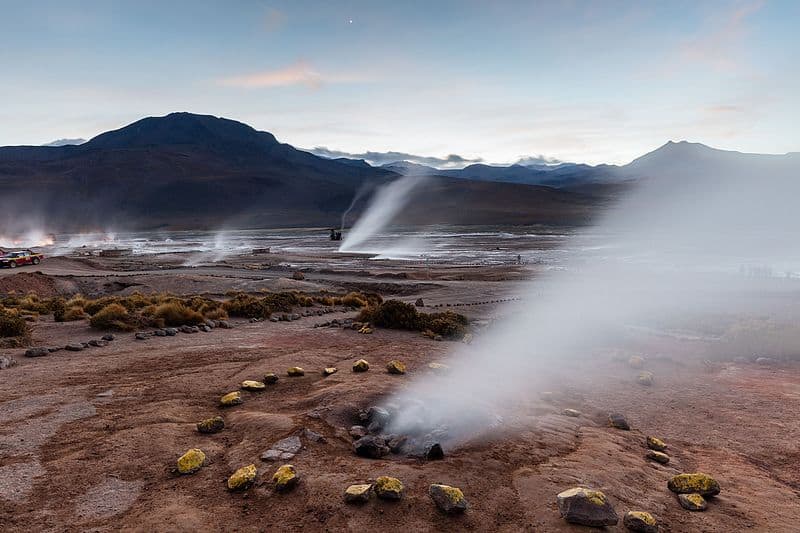
El Tatio Facts
- The simple term of El Tatio serves as the most often employed name for this majestic marvel of geological forces. The precise meaning of this term remains something of a mystery, however. That’s because it stems from what’s now an extinct language.
- The word tatio itself orginates in the native tongue of the local Indigenous Peoples, the Kunza. That tongue’s been considered functionally extinct since at least 1949. Yet, even in that language the word possesses multiple uses, thus creating the confusion.
- Its myriad original meanings included burnt, grandfather, oven, and appear. No known record exists of which of these, if any, the native inhabitants of the region intended. The formation’s also known as the Copacoya geysers, after a local mountain.
- The magnificent El Tatio holds many claims to fame. It ranks as the third-largest of all known geyser fields on the planet. It also qualifies as the largest in its entire hemisphere. Combined with its beauty, these make it quite famous in certain circles.
- Despite its inhospitable nature, these very qualities provide it with a unique status. Within the country it formed in, the site now represents a major tourist draw. Thankfully, the local government declared the formation a protected area in 2010.
Related Articles
Boiling Lake Dallol Hydrothermal Field Old Faithful
El Tatio Physical Description
The astounding El Tatio captures the imagination of everyone fortunate enough to visit the wonder. It understandably does so largely due to to its very nature. Yet the site additionally impresses because of its myriad physical dimensions. Nature truly outdid itself here.
Overall, the geothermal field covers an expanse that measures approximately 12 sq mi (30 sq km). Some portions of that area show greater activity than others, of course. The majority of features appear in three separate sections. These cover 3.9 sq mi (10 sq km) in area.
Within this smaller region of the greater one, a vast array of impressive geological features appear. These include such marvels as hot springs, geysers, terraces, mud volcanoes, mudpots, and boiling fountains of water. The chimneys of extinct geysers also still exist.
Outside of these concentrated sections, Nature certainly isn’t idle. Within the surrounding portions of the field, multiple other activities remain ongoing. There, steam vents, hot springs, fumaroles, and even areas of steaming soil complete the eerily haunting landscape.
For the moment, researchers have confirmed the presence of a total of 110 separate and distinct manifestations of geothermal energy. The geysers draw the most attention, but these are small. Few of the expulsions of superheated water exceed 3.3 ft (1m) in height.
El Tatio Geothermal Location, Formation, and Ecology
The spellbinding site known as El Tatio formed in a region of the earth well known for the presence of numerous geological wonders. Given that fact, its general location probably won’t surprise anyone. Nature placed it within the borders of the contient of South America.
There, it sits inside the borders of the country of Chile. Its precise placement there puts it in the northern part of that land, close to the border with Bolivia. That same location also happens to place the geological marvel high up in the equally wondrous Andes Mountains.
The geothermal expanse arose in association with local volcanic activity. In fact, it lies at the western base of a series of impressive stratovolcanoes. These represented the sources of several massive volcanic eruptions during the period of 10 – 1 million years ago.
Several of the associated volcanoes in this mountain range continue to remain active to varying degrees. Though not conclusively proven, it’s considered a reasonable assumption that one or more of them provides the ongoing heat for the entire geothermal system.
Despite the extreme harshness of the region comprising El Tatio, life still appears here. In total, 90 recognized species of flora live in, and in close proximity to, the field. This principally consists of dry grasslands, but others, such as velvet-like plants named yareta.
Where plants live, animals usually do also. Not even this area is an exception to that tendency. Most fauna in the region are smaller, such as lizards, frogs, chinchilla, and viscacha. Llamas represent the only larger animal present in the area on a consistent basis.
Features Sharing Its Area
Mount Roraima Angel Falls Cano Cristales
Check out our other articles on 5 Spellbinding Scorpions, Jackfruit Tree, Yeti Crab, Kilauea, Giant Otter, Lord Howe Island Stick Insect, California red-sided garter snake
